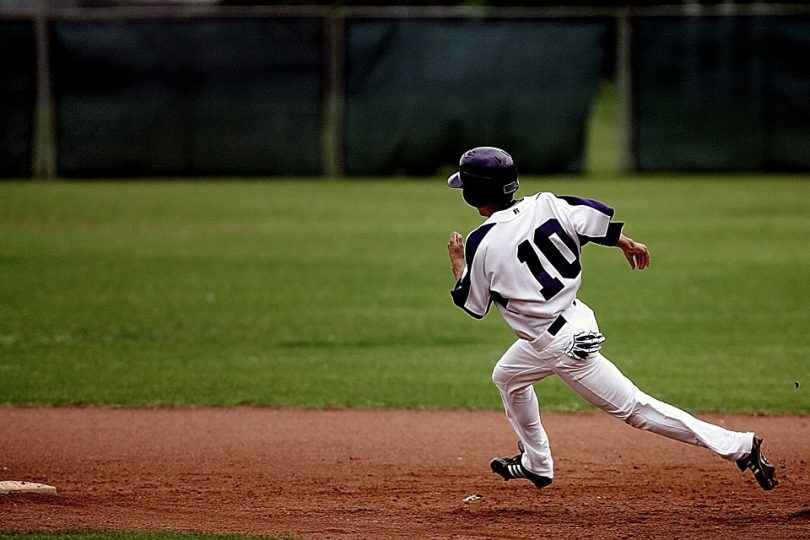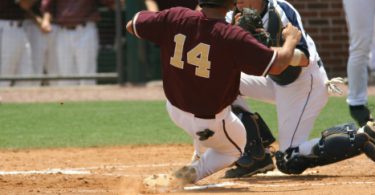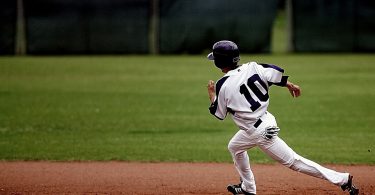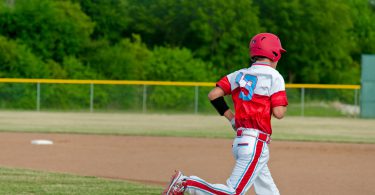By Ethan Guevin
The Situation: It’s a cold, overcast day and offense has been lacking on both sides. It is the bottom of the 6th, and the offense has a man on first with one out. They are down 1-0 and have had few scoring chances. The hitter gets ahead in the count 2-0.
The Play: The hitter gets a mistake fastball down the middle and takes a big hack. He just misses it and hits a high fly ball to deep right center. The outfielder has plenty of time to get under the towering fly ball for what should be a routine catch. The outfielder tracks the ball and is camped under it. Meanwhile, the runner at first gets as far off as he can and waits to read the play. Seeing that the outfielder is camped and the ball coming down towards the glove, the base runner puts his head down and starts to head back to first, assuming that the ball will be caught. As the ball comes down, the outfielder takes his eye off it to check the runner. When he tries to pick the ball up again, he loses it in the sky and it hits off his glove and drops at his feet.
The Outcome: The runner, hearing his 1st base coach yelling at him, locates the ball on the ground and heads toward second. The outfielder scrambles and fumbles to pick up the ball before getting a grip on it and throwing it in. By the time he gets it in to the second baseman, he is too late and the runner is safe at 2nd. The next hitter hits another deep fly ball that is caught for the second out. The pitcher then strikes out the following hitter to end the threat and the runners are stranded on first and third. The outfielder breathes a huge sigh of relief.
What Went Wrong?
You might think that we are going to focus on the outfielder, who certainly made plenty of mistakes himself. We rarely see a routine fly ball dropped, and the center fielder will undoubtedly be more focused on his next attempts. However, what we are going to talk about is a bigger problem in high school baseball—base running.
The mistake by the base runner on the dropped fly ball probably started to take shape several innings before the play. On a cold day with little offensive action, it’s easy to get used to the slow pace of the game and get lethargic, especially on the bases.
As soon as the fly ball was hit and the runner saw the outfielder camped, he ASSUMED the outfielder would make the play. This was his biggest mistake. You should always be anticipating a mistake or an opportunity to take an extra base. In this case, the base runner should have waited to see the ball secured by the outfielder before returning to tag up. He also could have used a better technique for extending on the fly ball.
Here is how runners who are extending as far as the fly ball allows should react in this situation:
Instead of extending as far as you can as quickly as possible, read the situation and anticipate the drop. As you extend, don’t take a huge lead and wait for the ball to come down. Instead, shorten your length, and as the ball comes down, step into your full distance with your momentum going to the next base. In other words, time getting out to your furthest point with the time the ball reaches the outfielders mitt. A lot of good base running is about anticipating, timing, and momentum.
As soon as the ball is secured by the outfielder, the base runner should turn around and hustle back to the base like normal. For the rare case where the routine ball is dropped, this technique will allow you to already have your momentum stepping towards the next base as the drop occurs. This will allow for the runner to get to the next base safely, and likely take an extra base.
If the runner in this instance used the proper technique with the appropriate timing, he would have made it to third base on the drop, and then scored on the deep fly ball. Who knows what would have happened after that, but at a minimum, the game would be tied.
Work on this technique in practice so when the rare drop occurs, you will be able to take advantage of it to the fullest. Just know that you may not be able to get quite as far off as usual, but your momentum will more than make up for that distance.







